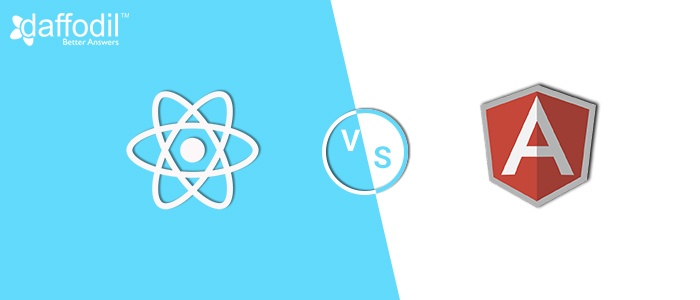
The front-end development ecosystem for web has been constantly upgrading, especially, the javascript libraries and frameworks. Had if these javascript applications not been there, developers would have to write five times the lines of code to accomplish a task, which a framework can do in ten lines. And what’s adding more power to them is huge community support that keeps bringing new possibilities for the progressive and dynamic web.
There are a number of JS frameworks available for front-end development. Angularjs, Emberjs, Vuejs, Reactjs are to name a few. Wider the options, it’s challenging to make up your mind for the one that complements your application requirement.
Here, we are going to compare two javascript-based, front-end development technologies-Angular (by Google) and React (by Facebook). By the end of it, you will be able to make a choice between the two, depending upon their potential and the type of application you are about to build.
AngularJS (JavaScript MVC Framework)
AngularJS is a structural framework that enable developers to build dynamic web pages. Introduced by Google in 2012, this javascript framework let the developers use HTML as template language and extend HTML syntax with new attributes to create Single Page Application (SPA). Some of the AngularJS features that are highlighted the most include:
- Dependency Injection: In AngularJS, dependency injection is software design pattern, wherein how components hold their dependencies are defined. As a result, the application needs no main () method and thus any component in the code which does not fit your requirement can be replaced.
- Angular Directives: With AngularJS, developers can extend HTML with new attributes, which are called directives. A developer can either define his own directives or use built-in directives within the framework. These directives help to extend functionality of the application.
- Two-Way Data Binding: The synchronization between model and view of the framework happens with data binding. If there are changes in the model data, it’s reflected in the view. And, the vice versa is true as well. This immediate and automated action ensures that both view and model are updated at all the times.
- On-Board Form Validation: Client-side validation is a crucial component of great-user experience. With AngularJS, developers can validate the form entries, without having to write JS code.
ReactJS (JavaScript Library for Building UIs)
ReactJS is an open-source, javascript library, specifically meant for rendering views. Unlike AngularJS, which is a JS framework providing model, view, and controller to manaze a website, ReactJS only processes the view. Once ReactJS is declarative in nature, i.e. when data changes, Rect conceptually hits the refresh button and updates only the changed parts. This enable the websites to render the results, fast. Some of the peculiar benefits of ReactJS includes:
- Virtual DOM: If there is one tech-specification that has to be highlighted to reflect contribution of ReactJS in an application’s performance, it would certainly be Virtual DOM. Instead of directly manipulating the DOM, React stores two copies of virtual DOM: the original one and the updated one (having the changes). These two versions of the DOM are run through a React function that checks out the difference between the two to render the parts of view that actually changed. This, as a result ensure that the changes in view are reflected faster.
- Server-Side Rendering: With ReactJS, the output can be rendered on both client and server side. This not only offer coding flexibility to coders but also give some breathing room to the Virtual DOM.
Choose ReactJS When:
For websites that have dynamically changing content, ReactJS proves to be a complementing technology. Today, most of the client-side websites wrestle to render large list of items in single view. This may affect efficiency of the website as a delay of milliseconds in rendering content may harm the user experience. So, if your website is going to have constantly changing, data-intensive content, hiring ReactJS developers is a great idea.
Popular ReactJS Websites: AirBnB, Facebook (partially), Instagram, Netflix, Imgur
Choose AngularJS When:
ReactJS was launched for developers back in 2013. The technology is not compatible with various old browsers (older than IE8). While the community is building large, there are still some questions that needs to be answered.
AngularJS is a comprehensive framework for frontend development and therefore, the time and skillset required to develop the website would be more than ReactJS. If a survey result by Stack Overflow is to be believed, developers ask more queries about AnguarJS than ReactJS.
However, with release of Angular v2.0, Google has given more performance-based reasons to choose AngularJS such as support for server-side rendering, two-way data binding, AJAX handling, modularization etc.
Popular AngularJS Websites: SanDisk, Google Express, Trello Developers, McDonalds (U.S.)
Recommended Reading:
ReactJS vs VueJS: Whone one to choose for your Web App Development



